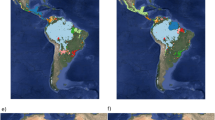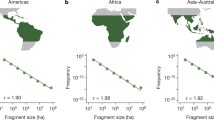Abstract
As tropical forests are complex systems, they tend to be modelled either roughly via scaling relationships or in a detailed manner as high-dimensional systems with many variables. We propose an approach which lies between the two whereby succession in a tropical forest is viewed as a trajectory in the configuration space of a dynamical system with just three dependent variables, namely, the mean leaf-area index (LAI) and its standard deviation (SD) or coefficient of variation along a transect, and the mean diameter at breast height (DBH) of trees above the 90th percentile of the distribution of tree DBHs near the transect. Four stages in this forest succession are identified: (I) naturally afforesting grassland: the initial stage with scattered trees in grassland; (II) very young forest: mostly covered by trees with a few remaining gaps; (III) young smooth forest: almost complete cover by trees of mostly similar age resulting in a low SD; and (IV) old growth or mature forest: the attracting region in configuration space characterized by fluctuating SD from tree deaths and regrowth. High-resolution LAI measurements and other field data from Khao Yai National Park, Thailand show how the system passes through these stages in configuration space, as do simple considerations and a crude cellular automaton model.






Similar content being viewed by others
References
Aleman J, Leys B, Apema R, Bentaleb I, Dubois MA, Lamba B, Lebamba J, Martin C, Ngomanda A, Truc L, Yangakola JM, Favier C, Bremond L (2012) Reconstructing savanna tree cover from pollen, phytoliths and stable carbon isotopes. J Vegetation Sci 23(1):187–197
Aubréville A (1938) La forêt coloniale: les forêts de l’Afrique occidentale françcaise. Ann Acad Sci Colon 9:1–245
Brockelman WY (1998) Study of tropical forest canopy height and cover using a point-intercept method. In: Dallmeier F, Comiskey JA (eds) Forest Biodiversity Research, Monitoring and Modeling: Conceptual Background and Old World Case Studies. UNESCO, Paris, pp 521–531
Brockelman WY, Nathalang A, Gale GA (2011) The Mo Singto forest dynamics plot, Khao Yai National Park, Thailand. Nat Hist Bull Siam Soc 57:35–56
Chambers JQ, Negron-Juarez RI, Marra DM, Vittorio AD, Tews J, Roberts D, Ribeiro GHPM, Trumbore SE, Higuchi N (2013) The steady-state mosaic of disturbance and succession across an old-growth Central Amazon forest landscape. Proc Natl Acad Sci USA 110(10):3949–3954
Chazdon RL (2003) Tropical forest recovery: legacies of human impact and natural disturbances. Perspect Plant Ecol Evol Systemat 6:51–71
Chazdon RL (2008) Chance and determinism in tropical forest succession. In: Carson WP, Schnitzer SA (eds) Tropical Forest Community Ecology. Wiley, Oxford, pp 384–408
Chazdon RL, Letcher SG, van Breugel M, Martínez-Ramos M, Bongers F, Finegan B (2007) Rates of change in tree communities of secondary Neotropical forests following major disturbances. Phil Trans Roy Soc Lond B 362:273–289
Clark DB, Olivas PC, Oberbauer SF, Clark DA, Ryan MG (2008) First direct landscape-scale measurement of tropical rain forest Leaf Area Index, a key driver of global primary productivity. Ecol Lett 11(2):163–172
Cournac L, Dubois MA, Chave J, Riéra B (2002) Fast determination of light availability and leaf area index in tropical forests. J Trop Ecol 18(2):295–302
Dislich C, Johst K, Huth A (2010) What enables coexistence in plant communities? Weak versus strong species traits and the role of local processes. Ecol Model 221(19):2227–2236
Dupuy JM, Hernández-Stefanoni JL, Hernández-Juárez RA, Tetetla-Rangel E, López-Martínez JO, Leyequién Abarca E, Tun-Dzul FJ, May-Pat F (2012) Patterns and correlates of tropical dry forest structure and composition in a highly replicated chronosequence in Yucatan, Mexico. Biotropica 44(2):151–162
Emmons LH, Dubois MA (2003) Leaf-area index change across river-beach successional transects in south-eastern Peru. J Trop Ecol 19(4):473–477
Emmons LH, Chatelet P, Cournac L, Pitman NCA, Vilca V, del Aguila LF, Dubois MA (2006) Seasonal change in leaf area index at three sites along a South American latitudinal gradient. Ecotropica 12(2):87–102
Enquist BJ, West GB, Charnov EL, Brown JH (1999) Allometric scaling of production and life-history variation in vascular plants. Nature 6756(401):907–911
Enquist BJ, West GB, Brown JH (2009) Extensions and evaluations of a general quantitative theory of forest structure and dynamics. Proc Natl Acad Sci USA 106(17):7046–7051
FAO (2010) Global Forest Resources Assessment. In: FAO forest paper No. 163, FAO. Rome, Italy
Favier C, Chave J, Fabing A, Schwartz D, Dubois MA (2004a) Modelling forest-savanna mosaic dynamics in man-influenced environments: effects of fire, climate and soil heterogeneity. Ecol Model 171:85–102
Favier C, de Namur C, Dubois MA (2004b) Forest progression modes in littoral Congo, Central Atlantic Africa. J Biogeogr 31(9):1445–1461
Ferment A, Picard N, Gourlet-Fleury S, Baraloto C (2001) A comparison of five indirect methods for characterizing the light environment in a tropical forest. Ann Forest Sci 58(8):877–891
Ghazoul J, Sheil D (2010) Tropical Rain Forest Ecology, Diversity and Conservation. Oxford University Press, Oxford
Guariguata MR, Ostertag R (2001) Neotropical secondary forest succession: changes in structural and functional characteristics. Forest Ecol Manag 148:185–206
Kellner JR, Clark DB, Hubbell SP (2009) Pervasive canopy dynamics produce short-term stability in a tropical rain forest landscape. Ecol Lett 12(2):155–164
Lebrija-Trejos E, Meave JA, Poorter L, Pérez-García EA, Bongers F (2010) Pathways, mechanisms and predictability of vegetation change during tropical dry forest succession. Perspect Plant Ecol Evol Systemat 12(4):267–275
Martin PH, Sherman RE, Fahey TJ (2004) Forty years of tropical forest recovery from agriculture: Structure and floristics of secondary and old-growth riparian forests in the Dominican Republic. Biotropica 36(3):297–317
Muller-Landau HC, Condit RS, Harms KE, Marks CO, Thomas SC, Bunyavejchewin S, Chuyong G, Co L, Davies S, Foster R, Gunatilleke S, Gunatilleke N, Hart T, Hubbell SP, Itoh A, Kassim AR, Kenfack D, LaFrankie JV, Lagunzad D, Lee HS, Losos E, Makana JR, Ohkubo T, Samper C, Sukumar R, Sun IF, Supardi MNN, Tan S, Thomas D, Thompson J, Valencia R, Vallejo MI, Muñoz GV, Yamakura T, Zimmerman JK, Dattaraja HS, Esufali S, Hall P, He F, Hernandez C, Kiratiprayoon S, Suresh HS, Wills C, Ashton P (2006) Comparing tropical forest tree size distributions with the predictions of metabolic ecology and equilibrium models. Ecol Lett 9(5):589– 602
Oliver CD, Larson BC (1996) Forest Stand Dynamics. Wiley, New York
Pacala SW, Canham CD, Silander JA Jr (1993) Forest models defined by field measurements: I. The design of a northeastern forest simulator. Can J Forest Res 23(10):1980–1988
Peña-Claros M (2003) Changes in forest structure and species composition during secondary forest succession in the Bolivian Amazon. Biotropica 35(4):450–461
Piotto D, Montagnini F, Thomas W, Ashton M, Oliver C (2009) Forest recovery after swidden cultivation across a 40-year chronosequence in the Atlantic forest of southern Bahia, Brazil. Plant Ecol 205(2):261–272
Putz FE, Parker GG, Archibald RM (1984) Mechanical abrasion and intercrown spacing. Am Midland Nat 112(1):24–28
Saldarriaga JG, West DC, Tharp ML, Uhl C (1988) Long-term chronosequence of forest succession in the upper Rio Negro of Colombia and Venezuela. J Ecol 76(4):938–958
Selleck GW (1960) The climax concept. Bot Rev 26(4):534–545
Shugart HH (1998) Terrestial Ecosytems in Changing Environments. Cambridge University Press, Cambridge
Tang H, Dubayah R, Swatantran A, Hofton M, Sheldon S, Clark DB, Blair B (2012) Retrieval of vertical LAI profiles over tropical rain forests using waveform lidar at La Selva, Costa Rica. Rem Sens Environ 124:242–250
Vincens A, Dubois MA, Guillet B, Achoundong G, Buchet G, Kamgang Kabeyene Beyala V, de Namur C, Riera B (2000) Pollen rain-vegetation relationships along a forest-savanna transect in southeastern Cameroon. Rev Palaeobot Palynol 110:191–192,197–208
West GB, Enquist BJ, Brown JH (2009) A general quantitative theory of forest structure and dynamics. Proc Natl Acad Sci USA 106(17):7040–7045
Acknowledgments
We are grateful to the Department of National Parks, Wildlife and Plant Conservation for permission to work in Khao Yai, and to the superintendents of Khao Yai National Park, Prawat Woharndee and Narong Mahannop, and their staff for their cooperation. We thank Anuttara Nathalang and her staff for providing data from Mo Singto plot and for their cooperation, and Luan Jannuan for his help in reconstructing the history of the park and thus giving a precise age to the different plots we studied. We are also happy to acknowledge many fruitful discussions with Laurent Cournac, Louise H. Emmons, Natsuda Klongvessa, Florian Hartig, and Nicolas Picard. The travel grant for Dubois and Favier was funded by the Franco-Thai programme. Some parts of this work were funded by the Faculty of Science Research Grants, Kasetsart University. Finally, we thank the two anonymous referees for their valuable comments.
Author information
Authors and Affiliations
Corresponding author
Appendix
Appendix
Cellular automaton model
The model is an n x × n y cellular automaton with periodic boundary conditions. Each cell represents a 5 m × 5 m quadrat and has values of LAI and DBH. The DBH corresponds to the DBH of the largest tree in the quadrat. Each time step (representing 1 year) is composed of two sub-steps: tree-falls followed by tree growth.
In the tree-falls sub-step, each cell with a DBH larger than d o has a probability p d of dying. Such a tree is assumed to be 50 m in height and falls in a random direction, killing trees where it falls (by setting those cells to zero LAI and DBH) with probability p dtf.
In the tree growth sub-step, if the DBH is nonzero, it is incremented by Δd up to a maximum of d max at the next time step. If the LAI is nonzero, it is incremented by ΔL up to a maximum of L max. If the LAI (and therefore also the DBH) of a cell is zero and is surrounded by k cells with an LAI greater than L s (using a 4-cell neighbourhood and so k = 0, 1, … , 4), the probability that the LAI becomes ΔL at the next time step is p wa+k p f. The parameters p wa and p f (both much less than 1) correspond to the probability of germination of seeds dispersed by, respectively, wind or animals, and falling from a neighbouring tree.
Initially, all cells have zero LAI and DBH. Values of M, S and V are found from the values of LAI along a line of n x cells in the x-direction. D is found from the values of DBH in these cells and the row of cells of the same length alongside.
Values of parameters used: n x = 40, n y = 21, d o = 32 cm, Δd = 0.4 cm, d max = 70 cm, ΔL = 0.2, L max = 7, L s = 2, p d = 0.01, p dtf = 0.2, p wa = 0.04, p f = 0.01. With the exception of the last three, which are difficult to estimate from the data available to us, the parameter values were chosen to be in line with field data. p dtf clearly only has an effect once trees start dying; increasing its value results in larger fluctuations in the OGF stage. In the model, p wa and p f are assumed to be small. Increasing p wa results in a more uniform YSF stage. The effects of changing p f are more complex and are coupled to other parameter values. But overall, the qualitative features of the model output do not depend on the precise choice of parameter values.
Rights and permissions
About this article
Cite this article
Chanthorn, W., Ratanapongsai, Y., Brockelman, W.Y. et al. Viewing tropical forest succession as a three-dimensional dynamical system. Theor Ecol 9, 163–172 (2016). https://doi.org/10.1007/s12080-015-0278-4
Received:
Accepted:
Published:
Issue Date:
DOI: https://doi.org/10.1007/s12080-015-0278-4




